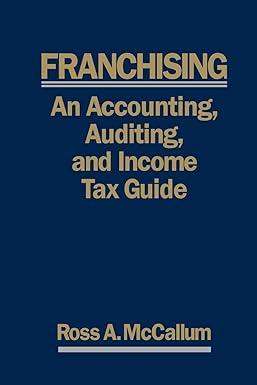Question
When the loan is first obtained, $300,000 will be posted in the long- term debt account and will appear on the balance sheet. At the

When the loan is first obtained, $300,000 will be posted in the long- term debt account and will appear on the balance sheet. At the end of the first year, Sunnyvale will pay the bank a total of $130,000, consisting of $30,000 interest on the loan and $100,000 repayment on the principal portion of the loan. The $30,000 interest expense, which is paid to the bank for the use of its money, appears as an expense on the income statement. The $100,000 principal repayment, on the other hand, is not an expense item, but rather it reduces the $300,000 carried in the long-term debt account on the balance sheet. In the second year, the loan will be treated in a similar way: $20,000 will appear as an expense on the income statement, and the loan amount on the balance sheet will be reduced by $100,000.
Tools Window Help Finance An Introduction to Accounting and Financial Management, Sixth Edition-Health Administration Press (2016).pdf (page 157 of 769) Q Search 132 Healthcare Finance Year 1 Year 2 Year 3 EXHIBIT 4.3 Sunnyvale Clinic: Bank Loan with Three- Year Maturity Loan Repayment Schedule: Interest on loan Principal repayment $ 30,000 100,000 $ 20,000 100,000 $ 10,000 100,000 Total payment $130,000 $120,000 $110,000 Industry Practice Leasing and Financial Statements Under current accounting rules (GAAP), leases are reported on a lessee's balance sheets in two ways. For long-term (capital) leases, the leased property is reported as an asset and the present value of lease payments is reported as a liability, But for short-term (operating) leases, the leased property does not appear on the balance sheet at all. Rather, operating lease obligations are reported in the notes to the financial statements Because short-term leases are not shown directly on the balance sheet, such leases are called off balance sheet financing. Note, however, that all lease payments are listed as expenses on the income statement, regardless of length It is likely that the current rules, in effect since 1977, will be replaced by new standards in $30,000 interest on the loan and $100,000 repayment on the principal portion of the loan. The $30,000 interest expense, which is paid to the bank for the use of its money, appears as an expense on the income state- ment. The $100,000 principal repayment, on the other hand, is not an expense item, but rather it reduces the $300,000 carried in the long-term debt account on the balance sheet. In the second year, the loan will be treated in a similar way: $20,000 will appear as an expense on the income statement, and the loan amount on the balance sheet will be reduced by $100,000. (The features of long-term debt are discussed in detail in Chapter 11.) In this scams as with man MacBook 80 F 000 4 F5 II FB 10 Tools Window Help Finance An Introduction to Accounting and Financial Management, Sixth Edition-Health Administration Press (2016).pdf (page 157 of 769) Q Search 132 Healthcare Finance Year 1 Year 2 Year 3 EXHIBIT 4.3 Sunnyvale Clinic: Bank Loan with Three- Year Maturity Loan Repayment Schedule: Interest on loan Principal repayment $ 30,000 100,000 $ 20,000 100,000 $ 10,000 100,000 Total payment $130,000 $120,000 $110,000 Industry Practice Leasing and Financial Statements Under current accounting rules (GAAP), leases are reported on a lessee's balance sheets in two ways. For long-term (capital) leases, the leased property is reported as an asset and the present value of lease payments is reported as a liability, But for short-term (operating) leases, the leased property does not appear on the balance sheet at all. Rather, operating lease obligations are reported in the notes to the financial statements Because short-term leases are not shown directly on the balance sheet, such leases are called off balance sheet financing. Note, however, that all lease payments are listed as expenses on the income statement, regardless of length It is likely that the current rules, in effect since 1977, will be replaced by new standards in $30,000 interest on the loan and $100,000 repayment on the principal portion of the loan. The $30,000 interest expense, which is paid to the bank for the use of its money, appears as an expense on the income state- ment. The $100,000 principal repayment, on the other hand, is not an expense item, but rather it reduces the $300,000 carried in the long-term debt account on the balance sheet. In the second year, the loan will be treated in a similar way: $20,000 will appear as an expense on the income statement, and the loan amount on the balance sheet will be reduced by $100,000. (The features of long-term debt are discussed in detail in Chapter 11.) In this scams as with man MacBook 80 F 000 4 F5 II FB 10
Step by Step Solution
There are 3 Steps involved in it
Step: 1

Get Instant Access to Expert-Tailored Solutions
See step-by-step solutions with expert insights and AI powered tools for academic success
Step: 2

Step: 3

Ace Your Homework with AI
Get the answers you need in no time with our AI-driven, step-by-step assistance
Get Started


